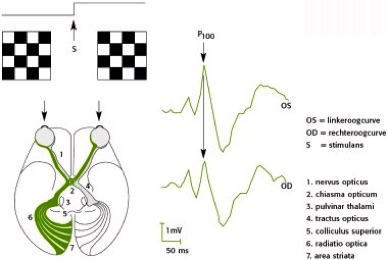A visual evoked potential is an evoked potential caused by a visual stimulus, such as an alternating checkerboard pattern on a computer screen. Responses are recorded from electrodes that are placed on the back of your head and are observed as a reading on an electroencephalogram (EEG). These responses usually originate from the occipital cortex, the area of the brain involved in receiving and interpreting visual signals.
When is the VEP used?
A doctor may recommend that you go for a VEP test when you are experiencing changes in your vision that can be due to problems along the pathways of certain nerves.
Some of these symptoms may include:
-
•Loss of vision (this can be painful or non-painful);
-
•Double vision;
-
•Blurred vision;
-
•Flashing lights;
-
•Alterations in colour vision; or
-
•Weakness of the eyes, arms or legs.
These changes are often too subtle or not easily detected on clinical examination in the doctor's surgery. In general terms, the test is useful for detecting optic nerve problems.
This nerve helps transfer signals to allow us to see, so testing the nerve allows the doctor to see how your visual system responds to light.
The test is also useful because it can be used to check vision in children and adults who are unable to read eye charts.
What does the VEP detect?
The VEP measures the time that it takes for a visual stimulus to travel from the eye to the occipital cortex.
It can give the doctor an idea of whether the nerve pathways are abnormal in any way. For example, in multiple sclerosis, the insulating layer around nerve cells in the brain and spinal cord (known as the myelin sheath) can be affected.
This means that it takes a longer time for electrical signals to be conducted from the eyes, resulting in an abnormal VEP. A normal VEP can be fairly sensitive in excluding a lesion of the optic nerve, along its pathways in the anterior part of the brain.
How to prepare for a VEP test
You will be given instructions on how to prepare for the test. This will depend on where you are going to get the test done.
Some things that you may need to do include:
-
•Washing your hair the night before, but avoiding hair chemicals, oils and lotions.
-
•Making sure you get plenty of sleep the night before.
-
•If you wear glasses, make sure you bring these along with you to the test.
-
•You are usually able to eat a normal meal and take your usual medications prior to the test. However any medications that may make you drowsy should be avoided.
-
•Arrive on time and try to relax before the test.
-
•On the day of the test, you should also let the technician know if you have any eye conditions such as cataracts or glaucoma as this can affect the test and should be noted in your records by the doctor.

De Lairessestraat 59 1071 NT Amsterdam 020-679 71 55 omca@me.com www.omca.nl


Oogziekenhuis OMC Amsterdam
Amsterdam Eye Hospital
De Lairessestraat 59 1071 NT Amsterdam 020-679 71 55 omca@me.com www.omca.nl
Amsterdam


Amsterdam Eye Hospital
Oogziekenhuis Amsterdam



